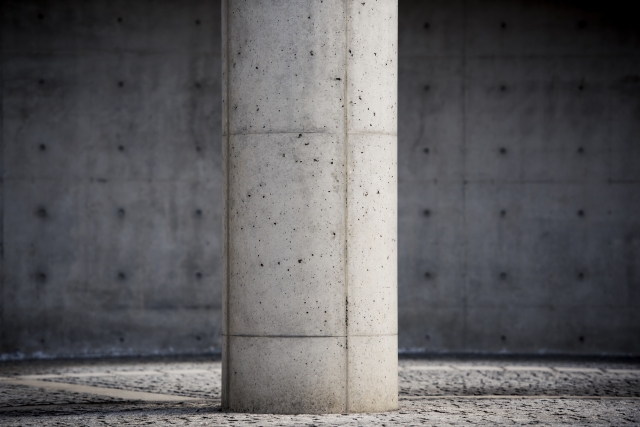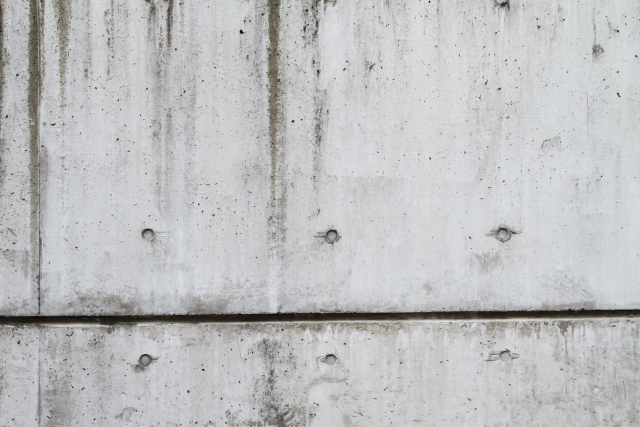
Services
Exposed Concrete
“Exposed concrete” is one type of finishing technique in reinforced concrete (RC) or steel reinforced concrete (SRC) buildings. It is made by pouring concrete into a formwork made of wood. Then, after confirming that the concrete has hardened and removing the formwork, the surface becomes visible. The structural concrete is visible upon completion, and it is left in that state giving it the name “exposed concrete finish”. Concrete is poured into the formwork and hardened, and after removing the formwork, a water repellent is applied to the outer wall to improve water resistance.
In RC / SRC apartments, the outer wall and the boundary wall with the next door are made of concrete, but since the In RC or SRC apartments, the outer wall and boundary walls are made of concrete. However, since the partition walls in the privately-owned parts of the building are made of drywall, they are generally covered with wallpaper or paint. Therefore, even in an exposed concrete apartment, not all walls have such a finish, and only some of the walls are exposed concrete.
Also, even if either the inside or outside wall has exposed concrete, there are buildings that finish the outside wall with tile or finish the inside wall with cloth or paint.
Concrete Plasterwork Restoration
When placing concrete, problems like “honeycomb” damage or cold joints, pock marks, etc. appear…
For the surface of the concrete, we can achieve a smooth and beautiful surface without bubbles by skillfully balancing all of the primary factors. Moreover, since it is alkaline, it will be neutralized by rainwater that has entered from the cracked part of the concrete surface over the years, and the reinforcing bars in the concrete will rust or expand, damaging the concrete surface.
The surface of exposed concrete that has not been properly finished is greatly affected by the environment, so it may deteriorate over time and cause various symptoms. It is important not only to eliminate these symptoms, but also to minimize the occurrence of new deterioration after maintenance for a long period of time.
Exposed Concrete Cosmetic Restoration

Wet concrete is poured into the formwork, and after it is confirmed that it has hardened the formwork is removed to reveal the exposed concrete surface. This hardened concrete surface, left as-is without any modification, is the “exposed concrete base finish”. Achieving a beautiful finish without any modification to the hardened concrete requires advanced technology and detailed site management.
In exposed concrete, as the hardened concrete base is used as the finished surface, the visuals become a very important factor in the finishing materials.
In addition, the untouched concrete itself is not yet highly durable and stain-proof. For this reason, after construction, a final coating is applied to provide durability and water resistance. It is important to improve durability and achieve a more beautiful finished surface. This beautiful finish is one of the greatest appeals to this occupation and showcases the craftsmen’s skills.
The work process includes shaping the honeycomb damage, pinholes, and cold joints with mortar.
The purpose of the special paint coating is to give an impression different from the material of the coated surface itself, unlike general paint coatings in which the specified color is applied evenly to the wall surface.
It is a painting technology that is also used in well-designed buildings such as multi-story buildings and offices, and includes depictions such as wood grain patterns or plastering patterns, and realistically expresses color blur as if it was created naturally due to deterioration over time.
After that, a water-based paint will be used to match the colors and draw a pattern.
In the final process, a water repellant is applied and the work is complete.
Exposed Concrete Water Repellent and Paint Coating

Durability is improved by preventing intrusion by rainwater and ultraviolet rays.
This is the clear water repellent used by our company. It is a material that prevents the aging process, makes it difficult for water to penetrate, and prevents chemical neutralization. It has excellent functionality, safety and environmental friendliness, and is widely used.
Without a protective coating, exposed concrete will get dirty in a few years. For this reason, a paint coating is applied so that the finish can be maintained for a long time while also maintaining the texture.
Just like the exposed concrete, if there is no protective layer to protect the outer wall, not only does the dirt contained in water adhere to the surface, but also dust is brought by rainwater. By applying a transparent water repellent material, you can expect durability to be maintained without changing the appearance. The completed water-repellent wall repels moisture well, so that dirt does not settle on the surface or can be easily washed away with water or pressure washing.


Benefits of Exposed Concrete Restoration
- Concrete can be restored to a condition like a brand-new construction.
- Even if honeycombs or pock marks appear, the concrete can be cosmetically restored in sections so that it fits with the surrounding concrete, and future problems can be avoided.
- Even in cases in which the formwork is removed and the color is different than imagined, it it possible to fix the color using water-based paint or cement.
Drawbacks of Exposed Concrete Restoration
- Color matching – the restored parts and original concrete may look different depending on the viewing angle.
- Depending on the shape of the building, the color of the concrete may look different on rainy or humid days.
- Color unevenness may occur over time because the deterioration speed of the restored part is different from that of the original concrete.




